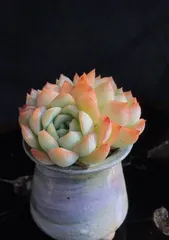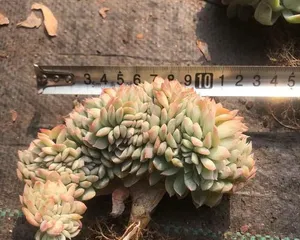Succulents have always been very popular, with the Sasha Queen being a particular favorite. This succulent attracts many enthusiasts with its beautiful appearance and easy propagation. However, if we don't know how to properly care for and propagate them, they may wither or die. In this article, we will introduce how to properly care for and propagate the succulent Sasha Queen.

I: About the Sasha Queen Succulent
The Sasha Queen is a precious succulent with very rich colors and extremely beautiful flowers. Due to its drought tolerance and ease of propagation, it is becoming increasingly popular in home gardens. However, it is not easy to keep them healthy and long-lasting. Below, we will introduce how to properly care for and propagate the Sasha Queen succulent.
II: Sunlight and Temperature
Succulents prefer warm environments and need to maintain an appropriate temperature for growth. The Sasha Queen requires plenty of sunlight, but also needs some shade during the hot summer months. We can move them indoors on hot days or use a shade net to block the sun. Additionally, succulents like cool, ventilated environments and can survive in low temperatures.

III: Watering
Succulents require less water because they store enough moisture to cope with extreme drought. In the summer, we need to maintain the humidity for Sasha Queen succulents, but not as much water is needed in the winter. Overwatering will cause the roots to rot and slow down the plant's growth. The correct watering method is to water once a week, ensuring the soil is dry before watering again.
IV: Soil
Succulents need soil with good drainage and aeration. It is best to choose sandy or gravelly soil. Do not use soil that contains fertilizer or decaying organic matter, as this can cause the succulent to grow excessively and may lead to root rot.
V: Propagation
The Sasha Queen can be propagated by leaf cuttings. Insert the leaves into dry sand and wait for roots to develop before transplanting them into soil. Additionally, division can be used for propagation, where the plant is separated into smaller parts and replanted. This method is more suitable for larger plants.

VI: Pruning
Removing leaves stimulates the growth of succulents, while pruning can control the plant's shape. If you want your succulent to become fuller and more compact, you need to prune it regularly.
VII: Fertilizer
Succulents do not need excessive fertilization, as this can lead to rapid growth without maintaining a stable growth state. It is recommended to fertilize once a month with diluted liquid fertilizer, and the amount can be moderately increased.
VIII: Pests and Diseases
Succulents are susceptible to aphids and spider mites, so regular inspection is very important. If pests are found, immediate action is required. You can spray with soapy water or alcohol. However, please do not spray in strong sunlight.
IX: Keep Dry
Succulents need to be kept in a dry environment because they are easily rotted by overly moist soil. If your succulents get wet on a rainy day, it is recommended to move them to a dry place.
X: Prevent Overgrowth
If you want your succulent to maintain its beautiful shape, you need to limit its growth. You can achieve this through proper pruning and restricted fertilization.
XI: Common Problems
Many people encounter common problems when caring for succulents, such as growing too tall or extending bare stems. These problems can be solved by proper pruning and restricted fertilization.
XII: Placement
Succulents can be placed on windowsills, balconies, or in indoor pots. However, please note not to place them in direct sunlight, and you need to rotate their positions regularly to ensure they receive enough sunlight.
XIII: Seasonal Care
The growth and care of succulents are related to the seasons. Different measures need to be taken in different seasons to maintain their health. For example, in winter, we need to reduce the frequency of watering and fertilizing, while in summer, we need to maintain the humidity of the succulents.
XIV: Repotting
Succulents usually need to be repotted once a year. When repotting, we need to use fresh sandy or gravelly soil and mix it together to ensure good drainage and aeration.
XV:
With proper care and propagation methods, you can keep the Sasha Queen succulent healthy and alive for a long time. Paying attention to aspects like environmental temperature, watering, fertilization, propagation, pruning, and pest and disease prevention can easily make you a succulent expert.